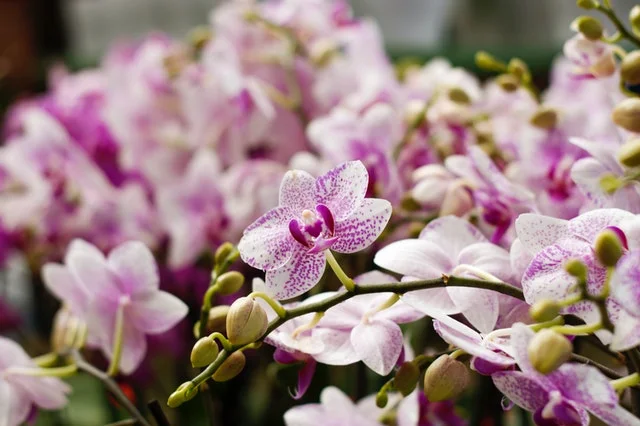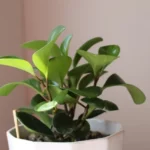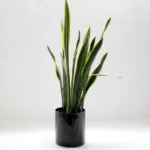Orchid is a popular houseplant, which improves your house’s aesthetics. It is easy to grow, hardy and has many color variations. However, most gardeners who tend to this plant have complained of their leaves starting to turn yellow.
It’s one of the major challenges since the orchid leaves’ appearance speaks a lot about their health state and if the leaves start to change their color, you don’t have to worry.
It could be a sign that they are getting older and will drop off soon. But it could also be sign of a deficiency, infection or excess sunlight.
If the yellowing starts at the bottom of the plant, then it’s a normal growth cycle. Plants shed off the older leaves to give room for younger ones.
However, if the leaves start to turn yellow from the top of the plant, then you should get alarmed. Some factors that contribute to the yellow leaves include low temperatures, overwatering and more.
Table of Contents
Top 7 Causes of Yellow Orchid Leaves and their Solutions
When your orchid plants turn yellow, then it might be due to the following factors:
Death of Old Foliage Leaves
Most times, the orchid leaves get discolored as part of their natural ageing cycle. When the orchid plant, like others, wants to grow new leaves, the older ones will turn yellow. The plant cuts the supply of water to the lower leaves.
The leaves usually start to turn yellow fast, wither and fall off after some time. This common shedding is because the plant finds the needs for growth and therefore gets rid of the “unnecessary” lower leaves. After some period, new leaves will grow on the plant.
How to know if the yellowing of the leaves is normal
When the leaves of your orchid plant start to yellow, don’t assume its normal. Observe how the leaves start to yellow.
During normal shedding, one or two leaves will start to turn yellow in the plant. Over time, these yellow leaves will start to wither and drop off after a while.
Avoid removing the withered leaves with your hands as you will increase the chances of infection. This is because you will be creating wounds in the plant, which is even unhealthier during the shedding process.
Instead, use a sharp knife after the leaves have completely turned yellow.
High or Low Temperature
One of the most common causes of yellow orchid leaves is abnormal temperature variation. Orchids are sensitive to temperature than most tropical flowers and plants.
Therefore, even if they are exposed for a few hours to extremely low or high temperature, then the leaves could yellow. Unless your plants were raised outdoors and are therefore hardy, maintain them at temperatures above 60 degrees F.
If the temperature drops below the optimum 60 degrees, then the leaves can turn yellow. Additionally, it would help if you avoided temperatures of 75-80 degrees F, mostly when the plants are enclosed in a structure.
How to fix temperature issues?
If your orchid plants start to turn yellow due to temperature issues, then it’s easy to fix them. But you will need a thermometer to check the temperature and adjust it accordingly. The window can also affect the temperature, especially during summer or winter.
Overwatering
Since orchids are epiphytes, they love nestling in the roots and trunks of trees to ensure their roots remain dry.
If you add more water to the pot, then the roots could smother, which can cause the leaves to become yellow after a short time.
The first sign of overwatering is reduced leaf growth. Thereafter, the leaf growth may stop and the other leaves will start to turn yellow. When this occurs, trim the over soft and black roots and drain the excess water via the pot’s drain holes.
How to fix it
Many homeowners usually overwater their orchid plants for a reason. They love the plants, and therefore, they’re trying to enhance their chances of success.
If the challenge is excess water, then just reduce the amount of water you are putting into your plants. Also, check the potting medium for signs of dampness and drain excess water.
Disease
Diseases are also one of the top causes of yellowing in orchid leaves. They can be a fungal infection or a bacterial infection. If it’s a fungal infection, your orchid will start to have a spotty appearance but with a good smell.
These infections mostly start as yellowing on the leaves’ sides and soon become brown.
On the other hand, if there is a foul smell, it’s likely a bacterial infection. Remove the infected leaves from other plants using a razor blade.
Too Much Light
If your plant’s leaves are still firm and plump, but its color is turning yellow, then it’s likely that it’s receiving too much sunlight. Excess sunlight washes out the normal green color, and this is common in orchid plants.
If this is the case, then move the plant to a place with less indirect sunlight. For instance, if the plant is in the windowsill, then ensure it is facing the west or north. should face the west or north.
Nutrient Deficiency
You should always apply nutrients to your plants since nutritional deficiencies can make your orchid plants change color. Though you may assume that the plant has enough nutrients, they don’t last for long.
It’s common for a plant to lack nutrients such as zinc, iron, nitrogen and manganese. Apply fertilizer weekly to deal with this problem.
Exposure to Chemicals or Hard Water
The orchid plant is sensitive to hard water or those which contain high quantities of chlorine.
The plant cannot process these chemicals effectively, and the higher quantity of calcium and magnesium also makes it hard for the plant to absorb some nutrients, resulting in nutrient deficiencies. Therefore, use only soft water to water the plants.
Bottom-line
If your orchid leaves start to turn yellow, then go through our seven tips to determine their problem.
It could be natural but can also be other factors such as overwatering, infections and more. Once you find out what is causing the yellowing, fix the problem.
Photo by Miguel Marmolejos Fernández from Pexels


